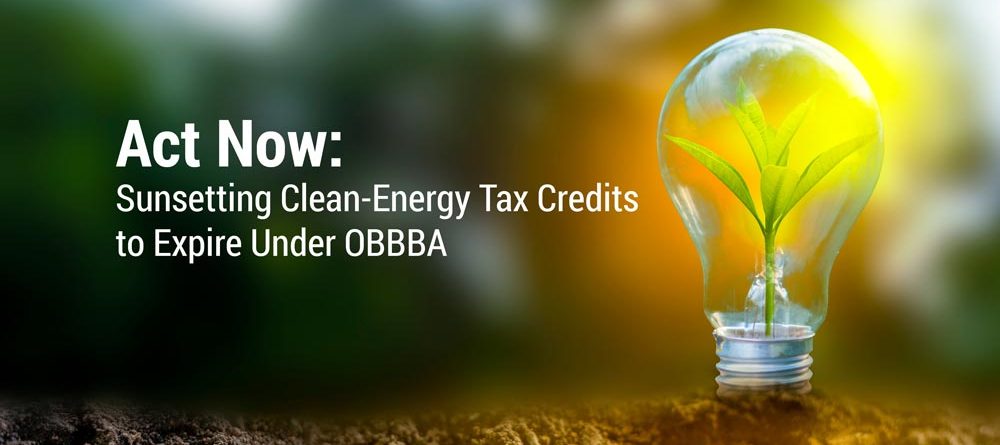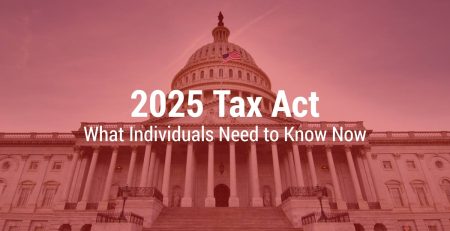Sunsetting Clean-Energy Tax Credits to Expire Under OBBBA
On July 4, 2025, Congress enacted a sweeping tax reform, dubbed the “One Big Beautiful Bill” Act (OBBBA) and it brings significant changes to several popular energy-related tax credits. It accelerates the expiration of several clean-energy tax credits originally extended under the Inflation Reduction Act, creating critical windows for action.
Here is a breakdown of the key credits nearing sunset, their expiration dates, and what individuals and companies can do now:
Clean Vehicle Credits (Personal & Commercial)
- What’s Changing:
- New Clean Vehicle Credit (Section 30D) for new EVs
- Previously-Owned Clean Vehicle Credit (Section 25E)
- Commercial Clean Vehicle Credit (Section 45W)
- These all expire for vehicles acquired after September 30, 2025.
- Key Details:
- Qualifying new and used EV purchases must be completed by 9/30/2025 to qualify.
- New EVs may yield up to $7,500, while used EVs may offer up to $4,000, subject to MSRP, final assembly location, and income thresholds.
- Commercial purchasers may claim up to $40,000 (or up to 30% of purchase price) for heavier vehicles.
- Action Items:
- Finalize qualifying EV purchases (ordered and acquired) as soon as possible—by September 2025.
- Review vehicle eligibility and your income filing status.
- Work closely with dealerships to confirm delivery and title transfer before the deadline.
- Retain purchase documentation and consult your tax advisor for point-of-sale credit application options.
Energy-Efficient Home Improvements & Residential Clean Energy
- What’s Changing:
- Energy-Efficient Home Improvement Credit (Section 25C): expires for property placed in service after December 31, 2025. Includes upgrades like insulation, windows, doors, and certain HVAC systems.
- Residential Clean Energy Credit (Section 25D): including solar, geothermal, battery storage—expires for expenditures made after December 31, 2025.
- Key Details:
- These credits currently provide up to 30% of the cost of qualifying energy-saving upgrades or clean energy installations.
- After 2025, no tax credits will be available for these improvements or installations.
- Action Items:
- Schedule installations now to ensure placement in service or expenditure occurs by 12/31/2025.
- Prioritize projects such as solar panels, heat pumps, efficient HVAC systems, insulation, windows, and battery storage.
- Keep thorough records—contracts, invoices, installation dates, and energy-saving certifications—to support your tax filing.
Navigating these new tax changes can be complex—but the potential savings are substantial. Learn exactly how the 2025 changes will affect your situation and to develop a personalized tax strategy that maximizes your benefits.
Commercial Building & New Home Energy Efficiency Credits
- What’s Changing:
- Energy-Efficient Commercial Buildings Deduction (Section 179D): expires for property beginning construction after June 30, 2026.
- New Energy-Efficient Home Credit (Section 45L): expires for homes acquired after June 30, 2026.
- Key Details:
- 179D: Applies to new construction and retrofits that meet energy efficiency standards for qualifying commercial buildings (e.g., lighting, HVAC, etc.)
- 45L: Provides up to $5,000 per unit for new or substantially reconstructed ENERGY STAR or ZERH homes.
- Action Items:
- Schedule construction to begin by June 30, 2026, to qualify.
- Coordinate early with your architect, builder, and tax advisor to meet design, documentation, and timing requirements.
- Confirm ENERGY STAR or Zero Energy Ready Home certification where applicable.
Advanced Renewables & Other Clean Energy Production Credits
- What’s Changing:
- Clean Electricity Production Credit (Section 45Y) and Clean Electricity Investment Credit (Section 48E): phased out for wind/solar facilities placed in service after December 31, 2027, unless construction begins by July 4, 2026.
- Clean Hydrogen Production Credit (Section 45V): expires for facilities with construction beginning after December 31, 2027.
- Key Details:
- Early development action is essential—eligible wind/solar projects must both begin construction by mid-2026 and be placed in service by end of 2027.
- Credits for hydrogen production face a hard cutoff for new facilities built after 2027.
- Action Items:
- For renewable energy developers: finalize permitting, engineering, and begin construction by July 2026.
- Document construction milestones and coordinate with tax professionals on credit election and compliance (including domestic content and FEOC rules).
- Use direct-pay or transferability provisions wisely to optimize tax efficiency.
Summary Table
| Tax Credit / Feature |
Expires… |
Act Now To… |
|---|---|---|
New & Used Clean Vehicle Credits (30D, 25E) |
After Sept 30, 2025 |
Purchase EVs by 9/30/2025 |
Commercial Clean Vehicle Credit (45W) |
After Sept 30, 2025 |
Purchase clean commercial vehicles by 9/30/2025 |
Home Improvements (25C) |
After Dec 31, 2025 |
Complete qualified upgrades by year-end 2025 |
Residential Clean Energy (25D) |
After Dec 31, 2025 |
Install solar, batteries, etc. by 12/31/2025 |
Commercial Buildings Deduction (179D) |
Construction begins after June 30, 2026 |
Start construction by 6/30/2026 |
New Energy-Efficient Home (45L) |
Homes acquired after June 30, 2026 |
Acquire homes by mid-2026 |
Electricity Production/Investment Credits |
Placed in service after Dec 31, 2027 (unless BOC by 7/4/2026) |
Begin construction by 7/4/2026 and place in service by 2027 |
Hydrogen Production (45V) |
Construction after Dec 31, 2027 |
Start construction before end of 2027 |
What Individuals and Businesses Should Do Now
- Review Your Project Pipeline
- Identify projects or purchases that may qualify for these credits and match them with the deadlines above.
- Accelerate Investments & Purchases
- If you are considering EV purchases, home energy upgrades, or clean energy installations, move up timelines to capture these credits before they vanish.
- Coordinate with Your Service Providers
- Builders, installers, and vehicle dealers need to understand timing constraints to ensure you remain eligible.
- Document Everything
- Keep track of purchase agreements, installation dates, construction start dates, certifications (e.g., ENERGY STAR), and level of service to substantiate tax claims.
- Collaborate with Your Accountant
- To maximize the benefit, coordinate election options (e.g., point-of-sale vs. claim on return), review how credits interact with your overall tax situation, and ensure compliance with emerging IRS and FEOC guidance.
Hungerford is Here to Help.
Navigating these new tax changes can be complex—but the potential savings are substantial. Reach out to Hungerford today to learn exactly how the 2025 changes will affect your situation and to develop a personalized tax strategy that maximizes your benefits.
Disclaimer: This blog post is for informational purposes only and does not substitute for personalized advice. Please consult your tax professional for guidance tailored to your situation.











